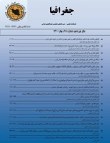Analysis of promoting and inhibiting factors of integrated rural-urban development: a case study of villages in the central part of Talysh County
It is very important to know the issues related to villages in socio-cultural, economic and environmental terms. Because sometimes the root of all the problems and issues of backwardness is caused by the migration of rural people to the city, which are also due to the lack of capital flow, lack of proper amenities, low income, reduction in the productivity of agricultural activities, and also the weakness in providing services to rural areas. The city and the village complement each other and their growth and development effects the whole complex. They also have mutual effects on each other, which sometimes causes tensions between the two. In this research, in addition to analyzing the promoting and hindering factors of integrated rural-urban development in the central part of Talysh city, it is tried to find solutions to establish balance in the relations of people in urban and rural society so that both can live together and continue their lives away from excellence. Therefore, the general goal of the research is to identify and analyze the factors that lead to the formation of integrated rural-urban development with positive and two-way performance in the villages of the central part of Talysh County
In terms of nature, the present research is an applied research and its governing approach is descriptive-analytical. Questionnaire and documentary and field methods were used to collect data. The statistical population of this research is all the residents of the villages in the central part of Talysh County. A multi-stage method was used for sampling. 23 villages were selected as samples. Cochran's formula was used to determine the sample size of households. The number of samples was equal to 351 households. The questions proposed in the questionnaire are closed questions and the questions are presented in the form of a five-choice Likert scale. Cronbach's alpha coefficient was used to calculate the reliability coefficient. The research variables are: infrastructural facilities and facilities, natural-ecological, agriculture, industry, services, social, education and research and manpower, management and planning. Two descriptive and inferential methods are used to analyze the data. Descriptive statistics are used to estimate the frequency and calculate the average and standard deviation of the data. In inferential statistics, structural equation method was used in LISREL software.
Based on qualitative content analysis of collected data through review of available sources and interviews, key concepts were extracted and during open coding, 41 inhibiting factors and 46 promoting factors of integrated urban-rural development were identified. Eight main groups of obstacles were identified including infrastructural facilities and facilities, natural-ecological, agriculture, industry, services, social, education and research and manpower, management and planning. In the ranking of the factors hindering the integrated urban-rural development based on the general change factor, the three main obstacles to development are manpower, management and planning with a change factor of 0.249, services with a change factor of 0.241, and education and research with a change factor of 0.234. It is considered integrated urban-rural. Also, based on the obtained results, the issues of low level of enjoying social and welfare services and infrastructure facilities, destruction of soil and water resources due to the use of chemical fertilizers and poisons in farms, low production efficiency in the agricultural sector, unwillingness of the private sector to invest In the industry sector in the villages, the lack of identification of the residential tourism potentials and the natural tourism facilities remaining unused, the slow movement in the formation of rural civil institutions in terms of legal, social and economic barriers, the lack of entrepreneurial platforms and the lack of areas for improving the urban management mechanism in line with urban development. In terms of the degree of impact on the lack of integrated urban-rural development, rural areas are ranked first. In the ranking of driving factors based on the coefficient of overall changes, the natural-ecological dimension with a coefficient of change of 0.240, services with a coefficient of change of 0.237, and the social dimension with a coefficient of change of 0.234 are considered to be three driving factors of integrated urban-rural development. Also, based on the results obtained, the texture and architectural pattern of the houses, suitable natural location, the possibility of developing greenhouse cultivation, having some industries inside the village and strong relations with Talysh city for buying inputs, processing and selling products, the presence of high natural tourism attractions. increasing the literacy rate in the villages and increasing the number of educated young people to improve their skills, the relative readiness of the socio-economic structure of the rural areas for education and accepting innovations and new activities and changing the attitude of the government, especially after the revolution, towards social justice and addressing the vulnerable groups in Deprived areas, especially villages, are in the first place in terms of the positive impact on integrated urban-rural development. Based on the evaluation results of the model with factor analysis, the model has acceptable overall fit criteria.
According to the surveys, there are 41 inhibiting factors and 46 promoting factors of integrated urban-rural development in the form of eight main groups including infrastructural facilities and facilities, natural-ecological, agriculture, industry, services, social, education and research and human resources, management and planning were identified. Manpower factor, management and planning, services, education and research are the three important factors that prevent integrated urban-rural development. The rest of the factors are in the next ranks. In the continuation of the results, the natural-ecological dimension, services and social dimension respectively were recognized as three important factors promoting integrated urban-rural development.
- حق عضویت دریافتی صرف حمایت از نشریات عضو و نگهداری، تکمیل و توسعه مگیران میشود.
- پرداخت حق اشتراک و دانلود مقالات اجازه بازنشر آن در سایر رسانههای چاپی و دیجیتال را به کاربر نمیدهد.



